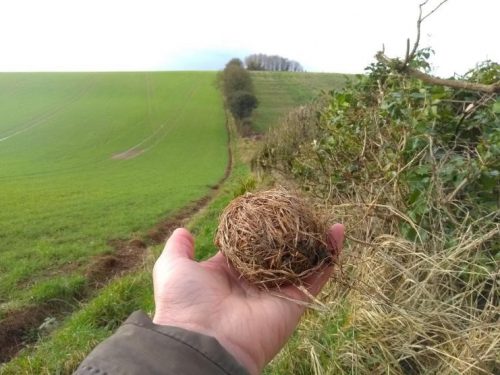Harvest mice are rarely seen, but they have distinctive nests which can be found if you know where to look. If present, they will occupy any suitable habitat, and may be very common where no records have been found previously.
- You will need a beady pair of eyes, tough gloves, and a farm field map. Some people like to use a stick to part vegetation.
- Nests are best found when vegetation is dying back in autumn and winter – choose overcast days between October-January. On sunny days it’s harder to see into shady areas.
- If you don’t know whether you have harvest mice, the objective is to find a nest. Look for woven grass spheres, ranging in size from clementine to tennis ball, or even orange. They may have a hole, but often don’t – the mice close it up on exit. Search in:
- Tussocks of tall grass (especially cock’s foot) in field corners and grass margins
- Tangled vegetation where tall grass blends into hedges and bramble
- Tussocks on beetle banks and in-field grass strips
- Reedbeds
- Game cover/wild bird seed strips with cereal or grass element e.g. reed canary grass
- If you have harvest mice, you can have a go at monitoring them from year to year. Once you are confident at finding them, identify 100-m lengths of suitable habitat and give yourself 30 minutes to search each length for nests. Record the search time and number of nests at each length and monitor the same sites in identical fashion from year-to-year.
A harvest mouse nest found in a tussock of grass on an arable margin © Jess Brooks

